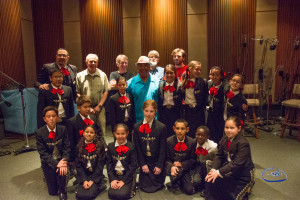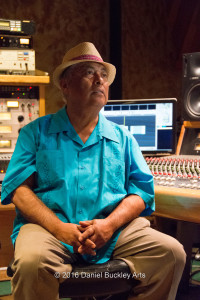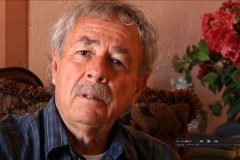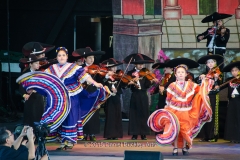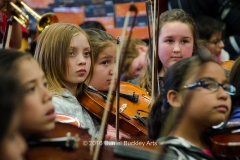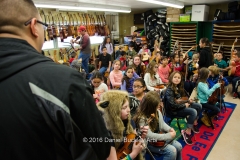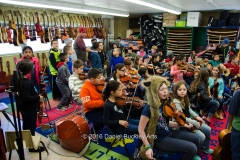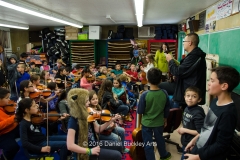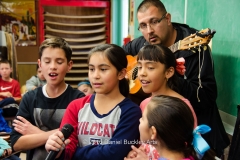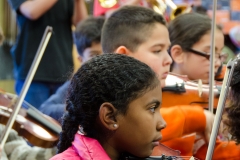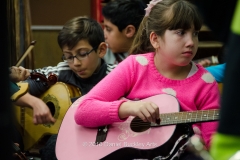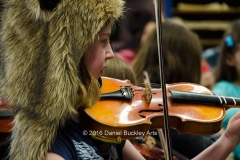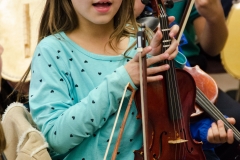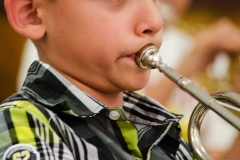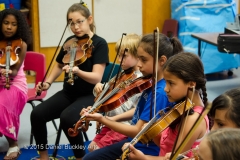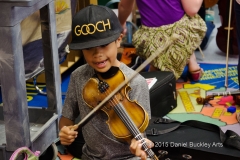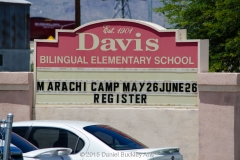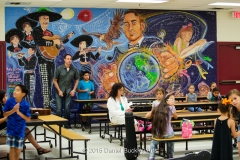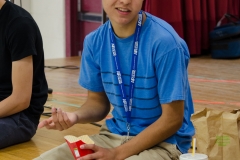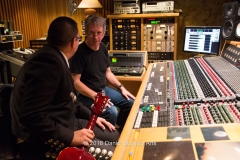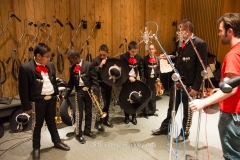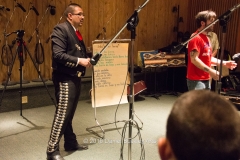In a cramped studio in a midtown Tucson neighborhood, a Tucson elementary school mariachi and an acclaimed children’s author and singer collaborated to bring a universal Woody Guthrie classic to a bilingual audience.
The singer was Jose Luis Orozco, the mariachi Las Aguilitas de Davis Bilingual Elementary School, and the place Jim Brady Recording Studios, where the likes of Linda Ronstadt, Mariachi Cobre, Giant Sand, Steve Earle, Neil Young, Brian Bromberg, Emmylou Harris and so many more had laid down tracks over the years.
Orozco had been presenting at the Tucson Festival of Books and heard Las Aguilitas performing. A talented mariachi comprised of fourth through sixth graders, the group and its director – Jaime Valenzuela – are among the great prides of Tucson. The group was founded by Jaime’s father, now retired teacher Alfredo Valenzuela, affectionately known as Dr. V. Both Valenzuelas were on hand for the session, with Dr. V busily tuning instruments and keeping the kids on task. The Davis Aguilitas, and now a few more elementary school programs around the city, form the first link in the pipeline that feeds the middle and high school mariachis Tucson takes such pride in.
Mr. Orozco could not have been a more likeable partner to work with. Patient, positive and anxious to get to know the kids, their parental chaperones and everyone involved, Orozco buoyed the mood at every stage of the five hour session.
Also joining in as Brady’s assistants were two Tucsonans who really know their way around a studio – Michael J. Ronstadt and his son, Petie. Michael and Petie are the nucleus of the international touring and recording ensemble The Ronstadt Generations, and Michael is singer Linda Ronstadt’s younger brother.
So how does it take five hours to record a three minute song? Well, you don’t just go in and record all at once. The song is recorded piece by piece and layered together. And every stage requires meticulous detail.
It took a while to lay down the tracks for the rhythm instruments and violins at the start of the session. First they had to balance the microphones so that every instrument could be recorded at the same strength. Moving just a few inches toward or away from the microphone could make the difference between getting the sound right and having to do it over again. Brady’s keen ears noticed a buzzing sound that turned out to be the metal ornaments on the trajes (uniforms) of the young mariachis. The Ronstadts helped to sort out every misstep and get things quickly back up to speed.
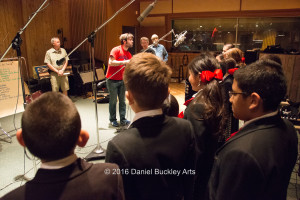
L-R, Alfredo Valenzuela, Petie Ronstadt, Jim Brady and Michael J. Ronstadt set up microphones for the vocal tracks.
Eventually all of the sound check issues were solved and after a few rehearsals, tracks started being laid down. Orozco was a huge help in keeping the group together, miming and mouthing the lyrics to help the kids remember where they were in the song without singing themselves. And it’s a very different experience when you’re used to singing while you’re playing your instrument.
After each take, Orozco, the Valenzuelas and the Ronstadts would head into the control room to carefully audition the finished track. Brady instinctively knew would could be fixed in the studio and what needed to be redone. For example, on the first run through the guitars tended to mute their instruments after the final notes. Jaime Valenzuela wanted them to let the instruments ring out until they decayed to silence on their own. It took a couple of tries to resist the temptation to mute the strings. But eventually those final bars sounded just right.
While the strings and rhythm section were at work, the trumpet players had to sit still and silent. But when their turn came, the others headed outside to play in the small courtyard. The trumpet players donned headphones to listen to the rhythm tracks. Jaime worked with his young musicians on creating a different, softer sound than they’re used to producing for the sessions. And again, it took a few passes to get things sounding good throughout, but they got there.
Next, the whole group gathered with Mr. Orozco to sing the song, first in English and then in Spanish. It took a while to arrange kids and microphones to get the ideal sound. But Brady and the Ronstadts had those issues knocked out in quick fashion. With Jaime and Alfredo Valenzuela riding herd, the vocal session went by quickly.
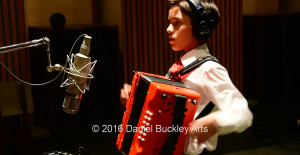
Davis Bilingual Elementary School fourth grader Andres Bentacourt prepares to lay down the accordion track on This Land is Your Land.
The bulk of the group left as the guitarrón player hung in, switching to button accordion to accent different passages. Though still learning the tune, he managed to get a fine version laid down in a few passes, laying in the tune a snippet at a time.
While he worked on that track, the rest took part in a ball game bouncing it off the wall of the building in the tiny courtyard out front. It was joyful fun and they were back to being exuberant kids again after having to stay so focused in the sessions.
Once Jaime, Brady and Orozco listened back to the combined tracks and decided that they had something quite good, the kids returned to Davis to resume classes.
Now it was time for Orozco to lay down his part.
And with that in the can, he and Brady huddled in the control room to discuss the final details.
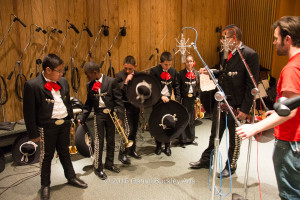 What had come together very quickly had turned into a very fruitful collaboration, and a beautiful rendition of the song, in English and Spanish, had been created. All took great pride in what they had achieved.
What had come together very quickly had turned into a very fruitful collaboration, and a beautiful rendition of the song, in English and Spanish, had been created. All took great pride in what they had achieved.

